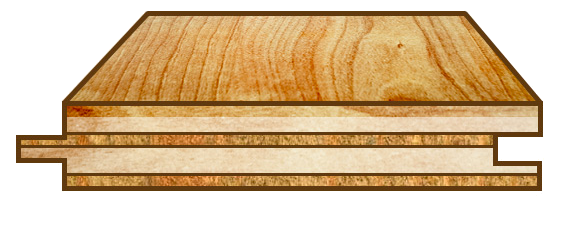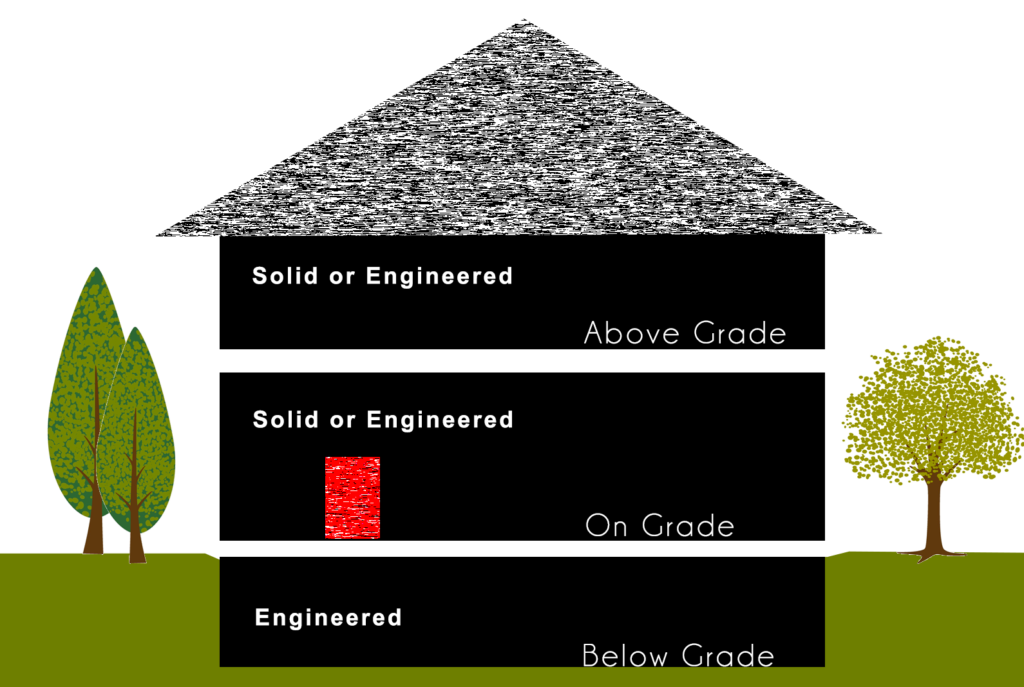The selection of your perfect hardwood floor does not have to be daunting. We are here to help educate you on the many types of available products. Whether you are replacing an old, damaged hardwood floor, laying a new floor over plywood or concrete, or looking for a more economical “floating floor,” let’s start the journey together.
Types of Hardwood Flooring
Once you have chosen between solid and engineered hardwood, you should choose the width of the strips/planks. Wood greater than 2-1/4″ wide is typically referred to as Plank flooring, whereas wood equal to or less than 2-1/4″ wide is typically referred to as Strip flooring. Most homes have 2″ or 2-1/4″ strip flooring, although plank flooring is a popular choice for retro spaces.
Hardwood Species
Do you prefer the traditional elegance of oak? Is the natural blonde color of maple appealing to you? There are dozens of hardwood and softwood flooring options out there, even though 99% of all homes have oak flooring. Picking out a type of wood is important as you consider which wood resists denting and scratch and which accepts a stain for readily should you plan of applying a stain. We assist you in these decisions.
Solid Hardwood Floors

Usually, solid hardwood flooring comes as the standard strip red oak flooring that is ¾ inches thick and 2 ¼ inches wide. While this is the most popular, solid hardwood flooring is available in numerous sizes between 3 ¼ inches and 6 inches plank flooring. It is possible to get flooring less than 2 ¼ wide, or larger than 6 inches wide but it has to be custom milled.
Floorboards come in general lengths from 12 inches to 84 inches. This helps the floor have a more natural look.
There are many species of hardwood available but the most popular are:
- Red Oak hardwood flooring
- White Oak hardwood flooring
- Maple hardwood flooring.

Engineered hardwood flooring is real hardwood. This can be the perfect middle-ground between solid hardwood and LVP. It is also very versatile and can be installed over plywood, concrete, on the main floor, second floor, and even the basement — in locations where solid hardwood is not suitable.
Many of our customers choose Engineered hardwood flooring for their home’s basement where moisture is common. Engineered hardwood floors can be glued directly to concrete subfloors and is a perfect solution for locations with extreme climate conditions.
Engineered hardwood flooring is available in the same colors, cuts, finishes, and surface textures as solid hardwood.
Hardwood Floors Center offers the most popular lines of engineered wood floors from trusted hardwood brands. With engineered hardwood flooring your home will have the attractive, durable, long-lasting value as traditional solid hardwood with at a more reasonable price.

Hardwood Floor Thickness
A Solid Hardwood floor is available in multiple thicknesses, manufactured to help match new floors to existing floors and provide a variety of flooring options for those looking for even more choices!
Thinner wood tends to cost more than thicker wood. This is due to the excess waste associated with milling thin wood – thinner pieces result in more waste, which must be figured into the cost of the product.
Wood is normally available in 1/4″, 3/8″ (for engineered floors), 1/2″, 9/16″, 5/8″, and 3/4″.
A thicker solid hardwood floor usually translates to a longer life, since the thicker floors can be sanded more times than a thinner floor.
Hardwood Floor Refinishing
Many people have beautiful hardwood hidden underneath their carpets, and even more, people have exposed hardwood that is dulled and unattractive. For those with existing hardwood, sanding and refinishing the floors is a great way to revitalize an old floor.
Hardwood can be sanded down to the raw wood (removing 1/32″ to 1/16″ of the top layer of your hardwood floor) and refinished with sealing coats of polyurethane. The sanding brings out the original beauty in the wood, while the polyurethane seals and protects the floor, providing a long-lasting finish.
Sanding and refinishing a floor is the best way to revitalize a floor, mainly because it is not very expensive, and the results turn out beyond expectations! Some people opt to stain their floors a darker color, such as mahogany. The staining process is done before the polyurethane and usually lasts until the floors are sanded again.
Unlike most flooring products, hardwood is durable and carries a long life. However, sanding the floors is not an infinite process, and it is possible to “run out” of sandings. This is normally evident when you can see the installer’s nails appearing between the boards of the floor. This is a good sign your floors cannot be sanded again.
Hardwood Flooring Costs
There are many things that have to be considered when determining the cost of hardwood floors. Typically, hardwood flooring costs between $8.00 and $12.00 a square foot (sq ft). The following factors determine who much you’ll pay for hardwood floors.
- Solid vs Engineered
- Plank vs Strip: How wide are the boards? Thicker is usually more expensive.
- Species: Red Oak is the most popular, and cost-effective. Pine and Maple are typically more expensive, Bamboo flooring is usually cheaper.
- Thickness: Thinner boards are more expensive because of the waste created. Companies factor this into the cost. Solid hardwood, which is thicker, cannot always be used due to sub-flooring and other factors.
- Brands: Some brands cost more than others because of quality and reputation.
Alpharetta, Johns Creek, Sandy Springs, Roswell, Duluth, Norcross, Cumming, Dunwoody, Brookhaven, Stone Mountain, Dacula, Snellville, Athens, Crabapple, Peachtree Corners, Flowery Branch, Buford, Gainesville, Lawrenceville, Fulton County, Gwinnett County, Forsyth County, Dacula, Braselton, Lilburn, Chamblee, Tucker, Embry Hills, Suwanee, Sugar Hill, Commerce, Monroe, Conyers, Covington, Redan, Graystone, Grayson, Rockbridge, Atlanta, North Druid Hills, Dawsonville, Dahlonega, Clermont, Cleveland, Toccoa, Clarkesville, Suches, Blairsville, Cornelia, Helen, McDonough, Locust Grove, Panthersville, Belvedere Park, Dekalb County, Clayton County, Hall County
